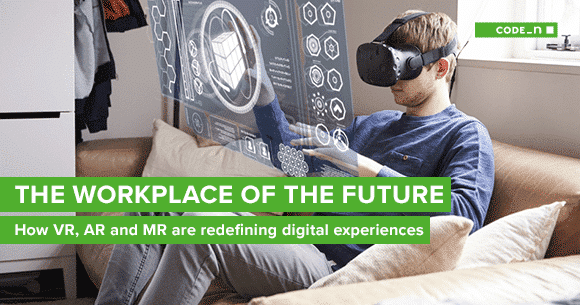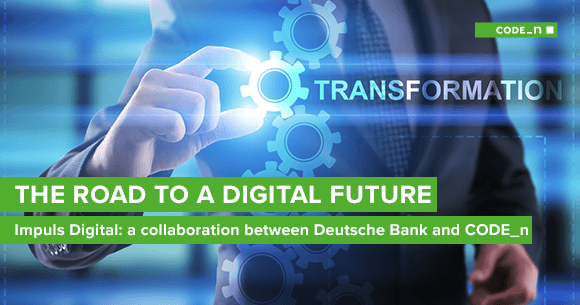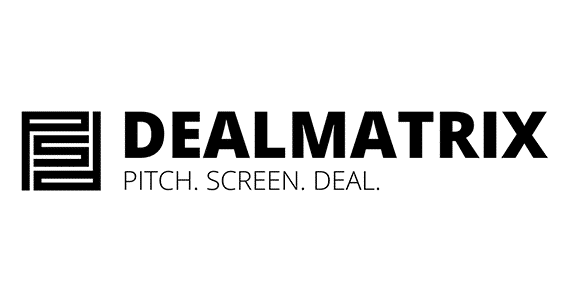The Future of Work with Mixed Reality

More and more companies are focusing their processes on digital transformation. The unlimited availability of data and information is fundamentally transforming business models. But processes and products are not the only things becoming more digital. The entire workplace of the future will also change. Immersive media such as augmented reality, virtual reality, and mixed reality will play a central role in this future of work.
The rise of immersive media
There is still a long way to go before virtual reality and mixed reality conquer private households everywhere. But the success of Playstation VR, Occulus, and HTC Vive shows that consumers are ready to enter the virtual world. But this area also holds huge potential for companies, both in internal and external communication and processes.
Organizations are already using virtual reality in their storytelling to make their communication more vivid and tangible. Rarely has it been possible to immerse people so deeply in a brand universe as with immersive media. People perceive content more intensely and remember what they have experienced better. But immersive media also play a central role in the work environment. They fundamentally change the working experience and enable employees to work in new and efficient ways.
The path out of the jungle of jargon
But what should we imagine when we hear terms like augmented reality, virtual reality, and mixed reality? Since the beginning of time, most new and emerging technologies have developed an unhealthy attachment to acronyms and things are no different with immersive media.
Here is an overview of the most common concepts. Virtual reality (VR) is an umbrella term for all immersive experiences that can be created from purely realistic content, purely synthetic content, or a hybrid of both. Augmented reality (AR) is a superimposition of content on the real world, whereby content is not anchored to it or part of it. The real content and the computer-generated content cannot interact with each other. The best of both worlds is probably found in mixed reality (MR), which gained popularity with the introduction of the Microsoft HoloLens. MR is the best of both worlds. It smoothly integrates virtual elements into the real world and interacts with its surroundings. The core of MR is that synthetic and real content can react to each other in real time.
With these definitions in mind, we can now look at different application scenarios in everyday work.
Immersive media in the office
HoloLens: Augmented Reality Office (source: Brand Scott)
In the near future, AR and MR will shape our daily work. Immersive technologies had a particular focus on gaming in the early years, but a change is now in sight. Apple, Google and co. are working on new smart glasses that enable users to easily transfer virtual content into their field of vision. The future may be that employees come to the office in the morning, log on to the company network with their data glasses, and see their entire workplace floating in front of them. You could create 3D animations, take notes, and send emails. All this with a single device, that almost completely replaces the classic monitor.
Such aspects will help increase productivity tremendously.
AR in corporate training
Industry 4.0: AR system for production (source: SCS Concept)
An obvious application for AR is training. In the medical field, the technology is already in use today for preparing complicated operations. But AR can also have a major influence on classic corporate training.
This technology provides real-time information, employees are guided step-by-step through processes via head-up displays or smart glasses, and people are shown the appropriate tools and actions directly in their field of vision. This is a logical replacement for classic operating manuals. Employees can focus more on the actual job without being distracted by the tedious task of looking back and forth.
VR in Marketing
Presentation of the AUDI Q7 (source: Audi)
Companies are expanding their marketing mix with new and innovative advertising instruments. At the beginning it was more the technology companies who relied on VR ads, but now Audi, Jaguar, and co. are also raising the bar in this field and moving into the fast lane. With VR, all products capable of conveying emotion have an opportunity not only to reach out to users, but also to inspire people on an emotional level.
The sensual experience offered by immersive media makes it possible to place customers directly at the center of the story. Some companies are already running pioneering campaigns with the help of VR and AR and they have made it possible to engage in unprecedented brand experiences.
MR in product design
Microsoft HoloLens: Partner Spotlight with Ford (Source: Ford/Microsoft HoloLens)
As in the previous examples, MR will supplement classic processes with meaningful scope for action. One example: product design. Designers will no longer depend on classic 3D programs on the computer. They can explore and optimize designs directly – up close.
With MR, designers can dive straight into their creation, view it from all angles, and optimize it on this basis. Being so close to an object gives you a completely different feel for its composition and function compared to conventional display options.
Tips for introducing immersive media
It’s always a tough process introducing innovations. The above examples should therefore be an inspiration, althouth there are many other ways in which immersive media will play a role in the future, for example in recruiting or user guidance.
As in most innovation processes, companies have to jump on the right trends. Just because something sounds incredibly inviting when you first stumble across it, it doesn’t necessarily means it’s a fit with your company. It needs “corporate innovation fit.”
By experimenting a little and engendering an open innovation culture that involves all employees, you can prepare for an immersive business case based on augmented reality, virtual reality, or mixed reality.
The future of virtual reality, mixed reality and augmented reality
These examples immediately reveal the potential of immersive media for the working day of the future. Employees experience completely new ways to collaborate through interaction – an approach detached from screens. At the click of button or voice command, an expert can be projected into the field of vision – somebody to provide help with a problem. With a camera built into his smart glasses or head-mounted display (HDM), the expert could see exactly what we see and send individual tips to the display. How we hold meetings will also fundamentally change in the short or long term. Holograms currently associated with science fiction films will become an integral part of our daily work within years. At first they will appear through glasses but later they will be detached from all hardware and act as a messenger bringing virtual content into our real world, similar to the role currently played by AR and MR. First experiments are already underway at Microsoft and a number of startups like Euclideon Holographics.
https://www.youtube.com/watch?v=GjPWk0UhKDQ
So the future of work is immersive. Companies should therefore already investigate today what potential this technology could offer them tomorrow. This will also allow businesses to start gearing themselves to the working world of the future.






Comments